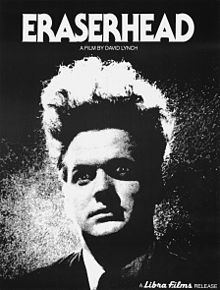| Eraserhead | |
|---|---|
 Theatrical release poster | |
| Directed by | David Lynch |
| Written by | David Lynch |
| Produced by | David Lynch |
| Starring |
|
| Cinematography |
|
| Edited by | David Lynch |
| Music by |
|
Production company | |
| Distributed by | Libra Films |
Release date |
|
Running time | 89 minutes[1] |
| Country | United States |
| Language | English |
| Budget | $100,000[2] |
| Box office | $7.1 million[2] |
Eraserhead is a 1977 American independent surrealist body horror film[3] written, directed, produced, and edited by David Lynch. Lynch also created its score and sound design, which included pieces by a variety of other musicians. Shot in black and white, it was Lynch's first feature-length effort following several short films. Starring Jack Nance, Charlotte Stewart, Jeanne Bates, Judith Anna Roberts, Laurel Near, and Jack Fisk, it tells the story of a man (Nance) who is left to care for his grossly deformed child in a desolate industrial landscape.
Eraserhead was produced with the assistance of the American Film Institute (AFI) during Lynch's time studying there. It nonetheless spent several years in principal photography because of funding difficulties; donations from Fisk and his wife Sissy Spacek as well as Nance's wife and crew member Catherine Coulson kept production afloat. It was shot on several locations owned by the AFI in California, Greystone Mansion, and a set of disused stables in which Lynch lived. Lynch and sound designer Alan Splet spent a year working on the film's audio after their studio was soundproofed. The soundtrack features organ music by Fats Waller and includes the song "In Heaven", written and performed for the film by Peter Ivers, with lyrics by Lynch.
Initially opening to small audiences and little interest, Eraserhead gained popularity over several long runs as a midnight movie. Since its release, it has been praised and considered a cult film. Its surrealist imagery and sexual undercurrents have been seen as key thematic elements, and its intricate sound design as its technical highlight. In 2004, the film was selected by the Library of Congress for preservation in the United States National Film Registry as being "culturally, historically, or aesthetically significant".[4]
- ^ "Eraserhead (X)". British Board of Film Classification. January 15, 1979. Retrieved March 18, 2016.
- ^ a b Cite error: The named reference
numberswas invoked but never defined (see the help page). - ^ Faulkner, Jason (October 31, 2017). "25 body horror movies that made our bones hurt". Syfy. Archived from the original on September 18, 2021. Retrieved April 23, 2023.
- ^ Cite error: The named reference
2004Addwas invoked but never defined (see the help page).